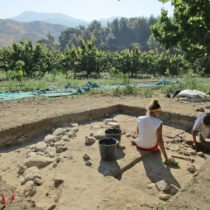The current research on the discovery, preservation, study and dissemination of ancient Greek texts is based on twentieth century data. In 1953, the news came that Michael Ventris and John Chadwick had deciphered the script written on the clay tablets, successively discovered since 1900 in Knossos, Argolis, Mycenae, Tiryns and Pylos. Ventris and Chadwick succeeded in refuting theories on the existence of eight other dialects and proved that the so-called Linear B was the “Mycenaean”, that is to say, the first Greek dialect. As a result of their finding, the first appearance of a Greek script was antedated and placed many centuries earlier. The thousands of tablets, were not, however, comprised of Greek literature but were mere inventories, that is to say, accounting records. Unfortunately only a small part of Greek literature has come down to us. Only a meagre 3% of the 1200 comedies and tragedies staged during the fifth and fourth centuries BC has been preserved. The intact or ruined monuments of antiquity, temples, arcades and theatres, have, on the other hand, remained tangible and authentic as opposed to the works of ancient literature that we only have in copies and not in the original. Many such copies, often dating from over a thousand years after the death of their creators ,have been discovered in monastic libraries of the medieval period. Seven out of the ninety tragedies by Aeschylus are known to us from their Byzantine copies, while the earliest complete testimony on Homer dates from the tenth century AD. The discovery, preservation and study of ancient Greek literature in the twentieth century has been both adventurous and impressive. One only has to think of the papyri found in the Egyptian desert, in which texts of archaic, Classical and Hellenistic Greece have been preserved, or the Epicurean library discovered in ancient Herculaneum under lava from the eruption of Vesuvius in 79 AD, or the two Greek philosophical treatises regenerated from the dried mud of Ai-Chanum in Afghanistan. New techniques in photography such as the multispectral, and new technologies in information, undoubtedly facilitate the reading and restoration of texts, whether through the correction of mistakes made in successive copying or through the deletion of possible word variations and misunderstandings of content.
The preservation of ancient texts and the story they tell
30 Aug 2012
by Archaeology Newsroom
- A
- A
- A

